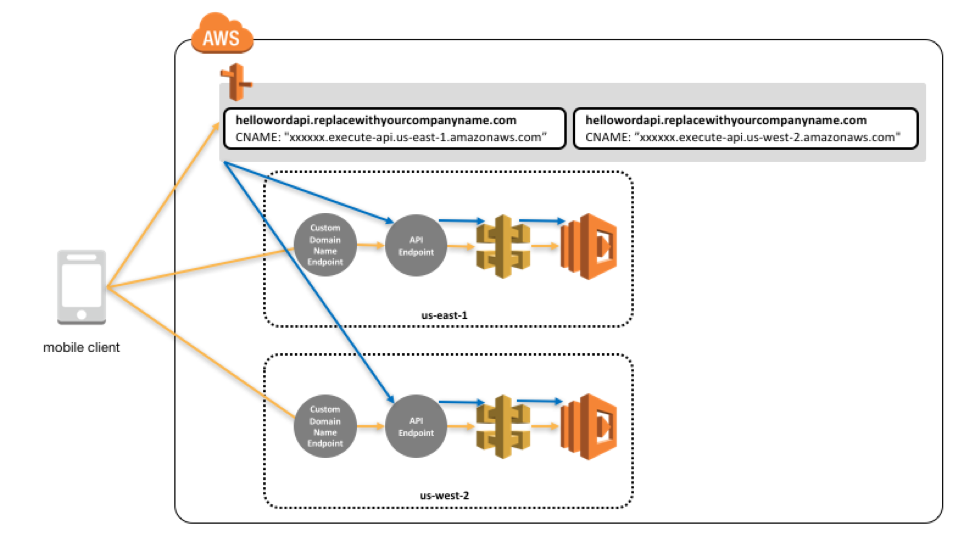AWS Compute Blog
Category: Amazon Route 53
Implementing multi-Region failover for Amazon API Gateway
This post is written by Marcos Ortiz, Principal AWS Solutions Architect and Khubyar Behramsha, Sr. AWS Solutions Architect. In this post, you learn how organizations can evolve from a single-Region architecture API Gateway to a multi-Region one, using a reliable failover mechanism without dependencies on AWS control plane operations. An AWS Well-Architected best practice is […]
AWS Lambda: Resilience under-the-hood
This post is written by Adrian Hornsby (Principal System Dev Engineer) and Marcia Villalba (Principal Developer Advocate). AWS Lambda comprises over 80 services working together to provide the serverless compute service that it offers to customers. Under the hood, many of these services are built on top of Amazon Elastic Compute Cloud (Amazon EC2) instances, […]
Enabling load-balancing of non-HTTP(s) traffic on AWS Wavelength
This blog post is written by Jack Chen, Telco Solutions Architect, and Robert Belson, Developer Advocate. AWS Wavelength embeds AWS compute and storage services within 5G networks, providing mobile edge computing infrastructure for developing, deploying, and scaling ultra-low-latency applications. AWS recently introduced support for Application Load Balancer (ALB) in AWS Wavelength zones. Although ALB addresses […]
Building highly resilient applications with on-premises interdependencies using AWS Local Zones
This blog post is written by Rachel Rui Liu, Senior Solutions Architect. AWS Local Zones are a type of infrastructure deployment that places compute, storage, database, and other select AWS services close to large population and industry centers. Following the successful launch of the AWS Local Zones in 16 US cities since 2019, in Feb 2022, AWS […]
Architecting multiple microservices behind a single domain with Amazon API Gateway
This post is courtesy of Roberto Iturralde, Solutions Architect. Today’s modern architectures are increasingly microservices-based, with separate engineering teams working independently on services with their own feature requirements and deployment pipelines. The benefits of this approach include increased agility and release velocity. Microservice architectures also come with some challenges, particularly when they make up parts […]
Creating static custom domain endpoints with Amazon MQ to simplify broker modification and scaling
Update – Nov 9, 2021: AmazonMQ also supports RabbitMQ – read Creating static custom domain endpoints with Amazon MQ for RabbitMQ for more information This post is courtesy of Wallace Printz, Senior Solutions Architect, AWS, and Christian Mueller, Senior Solutions Architect, AWS. Many cloud-native application architectures take advantage of the point-to-point and publish-subscribe (“pub-sub”) model of message-based […]
How To Migrate Multi-Tier Environments Using The AWS Server Migration Service
This post courtesy of Shane Baldacchino, Solutions Architect at Amazon Web Services. Many customers ask for guidance on migrating end-to-end solutions running on virtual machines over to AWS. This post provides an overview of moving a common WordPress blog running on a virtualized platform to AWS, including re-pointing the DNS records associated to with the […]
Event-Driven Computing with Amazon SNS and AWS Compute, Storage, Database, and Networking Services
Contributed by Otavio Ferreira, Manager, Software Development, AWS Messaging Like other developers around the world, you may be tackling increasingly complex business problems. A key success factor, in that case, is the ability to break down a large project scope into smaller, more manageable components. A service-oriented architecture guides you toward designing systems as a collection of […]
Building a Multi-region Serverless Application with Amazon API Gateway and AWS Lambda
This post written by: Magnus Bjorkman – Solutions Architect Many customers are looking to run their services at global scale, deploying their backend to multiple regions. In this post, we describe how to deploy a Serverless API into multiple regions and how to leverage Amazon Route 53 to route the traffic between regions. We use latency-based […]








